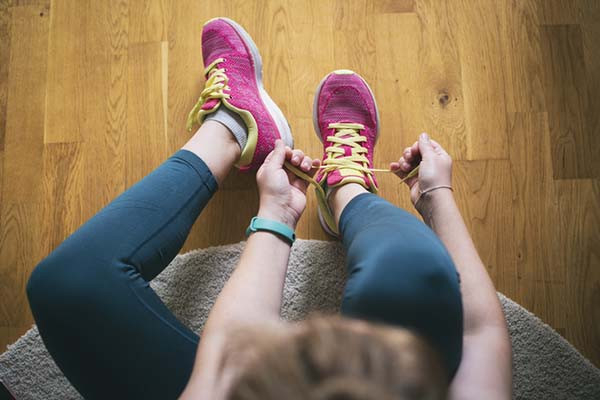
How do trees and green spaces enhance our health?

Trees enhance life in a multitude of ways. They combat climate change by reducing greenhouse gases in the atmosphere. They muffle sound pollution and reduce air pollution, drawing in carbon dioxide and releasing oxygen. When rain pours from the skies, trees decrease stormwater runoff, preventing flooding and soil erosion. They also provide valuable habitats to support biodiversity in insects, birds, and other animals, and microorganisms. The list goes on.
Equally important is accumulating evidence that simply spending time around trees and green spaces uplifts our health and mood. Below are a few of the biggest benefits we reap.
Keeping it cool: Trees help prevent heat-related illness
Climate change is causing rising temperatures and more heat waves across the US. These effects are worse for those who live in neighborhoods known as urban heat islands, where asphalt and concrete soak up heat during the day and continue to radiate it at night. Temperatures can reach 7° F hotter than suburban, rural, or simply wealthier and leafier neighborhoods.
Trees and their leafy canopy provide shade that helps to prevent urban heat islands. What does that mean for individuals? It translates to fewer heat-related health illnesses, which strike outdoor workers and younger, older, and medically vulnerable people more often. A study published in The Lancet calculated that increasing tree canopy to 30% coverage in 93 European cities could prevent an estimated four in 10 premature heat-related deaths in adults in those cities.
How trees help children: Better mood, behavior, attention, and more
Spending more time in nature has been linked with better health outcomes like lower blood pressure, better sleep, and improvement in many chronic conditions in adults. These findings are prompting a growing interest in forest therapy, a guided outdoor healing practice that leads to overall improved well-being. But what’s also remarkable are the varied benefits of trees and nature for children.
One study of children 4 to 6 years old found that those who lived close to green space demonstrated less hyperactive behavior and scored more highly on attention and visual memory testing measures compared with children who did not.
Just seeing trees can have mental health benefits. In Michigan, a study of children between the ages of 7 and 9 demonstrated that students who could see trees from their school windows had fewer behavioral problems than those with limited views.
In Finland, researchers modified daycare outdoor playscape environments to mimic the forest undergrowth. These daycares were compared to control standard daycares and nature-oriented daycares where children made daily visits to nearby forests. At the end of 28 days, the children in the daycares with modified forest undergrowth playscapes harbored a healthier microbiome and had improved markers of their immune systems as compared to their counterparts.
How green space helps communities
Having green space in neighborhoods also does a lot to enrich the well-being of communities. A randomized trial in a US city planted and maintained grass and trees in previously vacant lots. Researchers then compared these green spaces to lots that were left alone.
In neighborhoods below the poverty line, there was a reduction in crime for areas with greened lots compared to untouched vacant lots. Meanwhile, residents who lived near lots that were greened reported feeling safer and increased their use of the outside space for relaxing and socializing.
How can you help?
Unfortunately, urban tree canopy cover has been declining over the years. To counter this decline, many towns and nonprofit organizations have programs that provide trees for planting.
A few examples in Massachusetts are Canopy Crew in Cambridge and Speak for the Trees in Boston. (Speak for the Trees also offers helpful information on selecting and caring for trees). Neighborhood Forest provides trees for schools and other youth organizations across the US. Look for a program near you!
Planting trees native to your region will better suit the local conditions, wildlife, and ecosystem. Contact your regional Native Plant Society for more information and guidance. If you are worried about seasonal allergies from tree pollen, many tree organizations or certified arborists can give you guidance on the best native tree selections.
If planting trees is not for you but you are interested in contributing to the mission, consider donating to organizations that support reforestation, like The Canopy Project and the Arbor Day Foundation.
About the Author

Wynne Armand, MD, Contributor
Dr. Wynne Armand is a physician at Massachusetts General Hospital (MGH), where she provides primary care; an assistant professor in medicine at Harvard Medical School; and associate director of the MGH Center for the Environment and … See Full Bio View all posts by Wynne Armand, MD

Moving from couch to 5K

Need a little motivation and structure to ramp up your walking routine? Want to wake up your workouts but not quite ready for a mud run? Consider trying a couch-to-5K program.
Dr. Adam Tenforde, medical director of the Spaulding National Running Center at Harvard-affiliated Spaulding Rehabilitation Network and a sports medicine physician at Mass General Brigham Sports Medicine, shares tips on what to know and do before lacing up your sneakers.
What is a couch-to-5K program?
These free or low-cost coaching plans are designed to help would-be runners train for a 5-kilometer race, which is about 3.1 miles. The programs are available online, or as apps or podcasts. They typically feature timed walking and running intervals that gradually phase out the walking over a period of about nine weeks.
Why try a couch-to-5K program?
“One purpose of a couch-to-5K program is to give you time to acclimate and start to enjoy the benefits of running and the sense of accomplishment of completing a distance safely,” says Dr. Tenforde. Running provides many cardiovascular benefits, such as lower blood pressure and a reduced cholesterol level, as well as an enhanced sense of well-being, he adds.
What’s more, adding even short bursts of running or other vigorous physical activity to a workout — a practice known as high-intensity interval training or HIIT — appears to help improve mental health, according to a study that pooled findings from 58 randomized trials of HIIT.
Are you ready to tackle a couch-to-5K?
Even though the couch-to-5K programs sound as though they’re geared for completely sedentary couch potatoes, that’s not necessarily true, Dr. Tenforde cautions. These programs often assume you can walk continuously for 30 minutes, which doesn’t apply to everyone.
For some people, an even easier, more gradual training regimen may be more appropriate. Also, keep in mind that you don’t have to run to do a 5K. Many of these races also encourage walkers to participate as well. You’ll still reap the other rewards from committing to a race, such as being more challenged and motivated — and possibly more connected to your community. Many charitable “fun runs” benefit local schools or needy families. Some are in memory of people affected by illness or tragedy. Visit Running in the USA to find 5K races near you.
What to do before you start
If you’re planning to walk or run your first 5K, get your doctor’s approval before you start training. That’s especially important if you have heart disease or are at risk for it.
Comfortable walking or running shoes are a wise investment. Shoes that are too old or too tight in the toe box can cause or aggravate a bunion, a bony bump at the outer base of the big toe. Despite suggestions that people with flat feet or high arches need specific types of shoes, studies have found that neutral shoes (designed for average feet) work well for almost everyone. Walk or jog around the store when you try them on to make sure they feel good and fit properly.
You don’t need to buy special clothes; regular sweat pants or comfortable shorts and a t-shirt will suffice. Women should consider getting a supportive sports bra, however.
Go slow and steady when training
- Always include a warm-up and cool-down — a few minutes of slow walking or jogging — with every exercise session.
- If you haven’t been exercising regularly, start by walking just five or 10 minutes a day, three days a week. Or, if you’re already a regular walker, add some short stints of jogging to each walking session.
- Gradually add minutes and days over the following four to six weeks.
- Once you’re up to 30 minutes a day, check how far you’re traveling. Keep increasing your distance every week until you reach 5 kilometers. Then slowly phase in more jogging and less walking over your route if you like.
Remember that you can always repeat a week. You’re less likely to sustain an injury if you make slow, steady progress. Pay close attention to your body and don’t push yourself too much, Dr. Tenforde advises. Former athletes who haven’t run in years may think they can pick up where they left off, but that’s not a smart move — they should also start low and go slow.
For a good couch-to-5K guide, try this beginner’s program from the United Kingdom’s National Health Service.
About the Author

Julie Corliss, Executive Editor, Harvard Heart Letter
Julie Corliss is the executive editor of the Harvard Heart Letter. Before working at Harvard, she was a medical writer and editor at HealthNews, a consumer newsletter affiliated with The New England Journal of Medicine. She … See Full Bio View all posts by Julie Corliss
About the Reviewer

Howard E. LeWine, MD, Chief Medical Editor, Harvard Health Publishing
Dr. Howard LeWine is a practicing internist at Brigham and Women’s Hospital in Boston, Chief Medical Editor at Harvard Health Publishing, and editor in chief of Harvard Men’s Health Watch. See Full Bio View all posts by Howard E. LeWine, MD